
On the 3,000-acre White Stallion Ranch just outside Tucson there are 170 saddle horses. Experienced wranglers will make sure you are paired with a horse to match your ability level.
Not every guest at White Stallion Ranch schedules an equine-intensive day, but for me, horses, horses and more horses is what a dude ranch vacation is all about. So last year before Covid-19 descended I decided to visit three Arizona ranches close to Tucson. Its not as if I don’t get enough equine action; I have a horse of my own and ride several times a week. But visiting a dude ranch is another experience entirely. So when I was asked how I wanted to spend my first day I filled out the following schedule:
- 9 a.m: slow horseback ride
- 11 a.m.: fast ride
- Noon: quick buffet lunch
- 1 p.m.: riding lesson (focus on loping)
- 3 p.m.: quick dip in pool
- 4 p.m.: team penning
- 7 p.m.: steak cookout
- 8 p.m.: entertainment
- 10 p.m.: to bed
Fifty years ago, when TV Westerns were on prime time and the baby-boom generation (that’s me!) was glued to “Bonanza,” “Gunsmoke,” The Rifleman,” “Wagon Train,” “Rawhide” and “The Lone Ranger,” more than 30 dude ranches operated in the vicinity of Tucson. Now there are just two, with ten other member ranches in the Arizona Dude Ranchers’ Association scattered across the state.
Fast forward to the 1991 Western comedy “City Slickers,” and dude ranches (some owners prefer the gentler term “guest ranch”) came into the limelight again. But driving cattle through rattlesnake-infested streams is not what it’s about anymore.
Instead, think luxury accommodations, non-horse options like hiking, rock-climbing, fat-tire e-bike tours, UTV (utility task vehicle) tours, vintage rifle and pistol shooting, bird watching, evening entertainment and such, and you begin to get the picture of how guest ranches have evolved and diversified to appeal to families, single adults, girlfriend getaways and other non-traditional demographic groups.
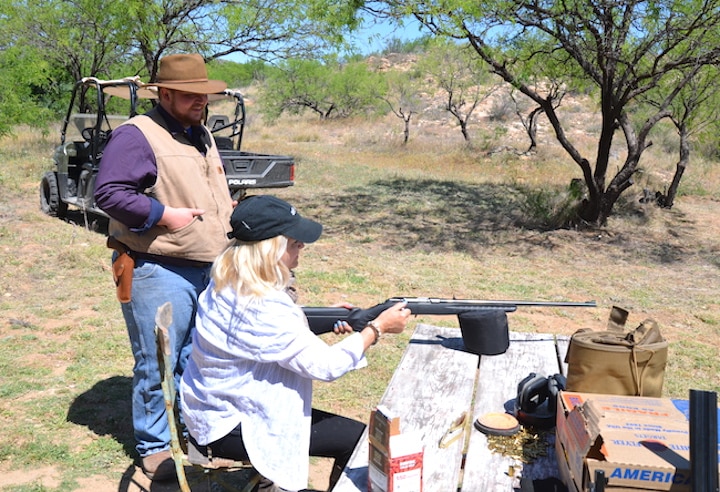
Dude ranches don’t allow hunting but they do offer supervised target shooting.
“The interest in guest ranching remains high,” says Mary Miller, president of the Arizona Dude Ranchers’ Association and part owner of Elkhorn Ranch, southeast of Tucson, which has been in her family for generations. “People who have discovered it are very passionate about the experience and come back year after year. Part of the challenge for us now is getting people to come for the first time. Whether or not they fall in love with horses and riding, it’s an amazing anecdote to urban life and getting the outdoors and nature into your life.
Do guests even have to like horses, much less get astride one? The answer is an unequivocal “neigh.”
“Our goal is always to be a horse-based ranch, but we’ve evened it out with more activities,” says proprietor Russell True, who grew up on White Stallion Ranch and has an ownership interest in the two other guest-ranch operations I visited.
All three caught me under their spell—and the only “City Slickers” (i.e. stupid) experience I had was tripping over my shoelace while taking a photo in a cactus garden and doing a full-on hand plant against a giant saguaro with inch-long spines. Ouch!
Rancho de la Osa, Sasabe
“In the middle of nowhere on the way to nowhere” is how True describes the historic ranch on the Mexico border that he and partners brought back to life in 2017 after it was shuttered several years. A 90-minute drive southeast of Tucson (you’ll encounter one or more border-control checkpoints on the way), the ranch appears abruptly like a sherbet-colored mirage in the midst of a dry and undulating desert sea.
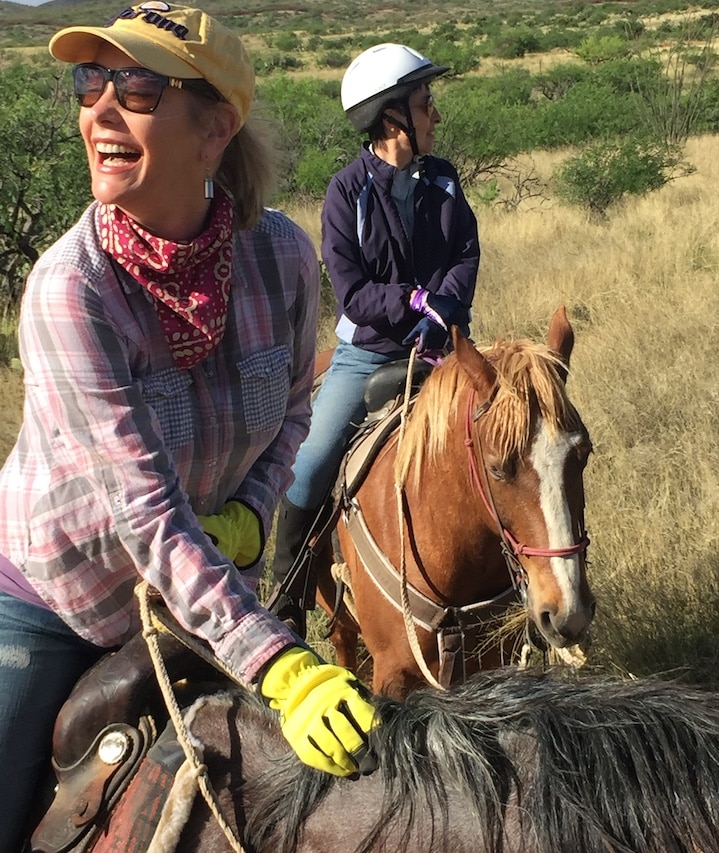
The best way to experience the Sonora Desert is from atop a horse. Except for the high summer months, the wether is surprisingly good.
Clambering out of the shuttle van, you see the main building, a former hacienda with foundations dating to the 1700s (the ranch was founded by Jesuits who traded horses and cattle in exchange for building an outpost for their mission) with bright turquoise Adirondack chairs on the veranda and vintage Western furnishings inside. Next to it is a smaller adobe building, once a chapel and now a cantina, built in the 1720s.
Spread out in two wings around a dirt courtyard studded with rather spectacular cactus plantings are two long, low, adobe guest-room buildings, 18 rooms in all, named after the many Hollywood, literary and political A-listers who made the ranch their hideaway from the 1920s into the 1950s and beyond. The short list includes Zane Gray, John Wayne, Gary Cooper, Joan Crawford, FDR, LBJ, Adlai Stevenson, William O. Douglas and William Clayton, who under the Truman administration was a guest here when he drafted the post-WWII Marshall Plan to rebuild European countries.
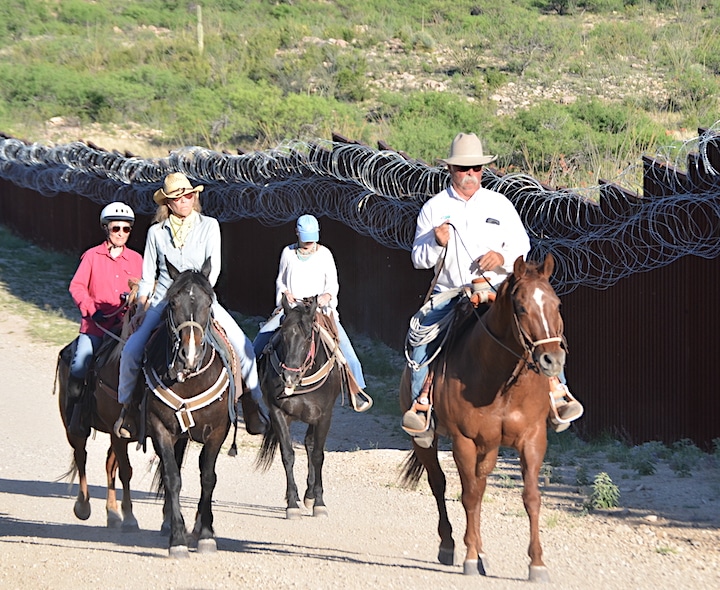
A new stretch of border fencing runs south of Rancho de la Osa along the Mexican border. Ross Knox leads a group of novice cowgirls on their first horseback ride.
A ranch hand will have to point out something else of interest: A snaking object on a far ridge, familiar from TV political news. Yes, it’s a portion of the infamous “border wall,” a miles-long section of tubular steel posts and wrapped on top with rolls of concertina wire.
Political posturing? Maybe. “We haven’t seen a terrorist yet,” deadpans Ross Knox, a long-time wrangler, packer and cowboy poet who, with wife Lynne, runs the place.
By mid-afternoon we’re assigned horses and head up the hill for a close-up look at the barrier (some guests opt instead to sight-see via UTV rather than by horseback), passing an ominous-looking security post along the way. A border-patrol helicopter chop-chops overhead, breaking the desert’s spell.
The odd thing about this section of fence: It stops abruptly at the territory of the indigenous Tohono O’odham people. They didn’t want it snaking into their land, but they welcome border patrol operations and listening posts. It’s easy to walk around the butt end of the barrier and we did, snapping photos in Mexico while our smartphones went, unexpectedly, into international calling mode, with accompanying charges. Go figure…
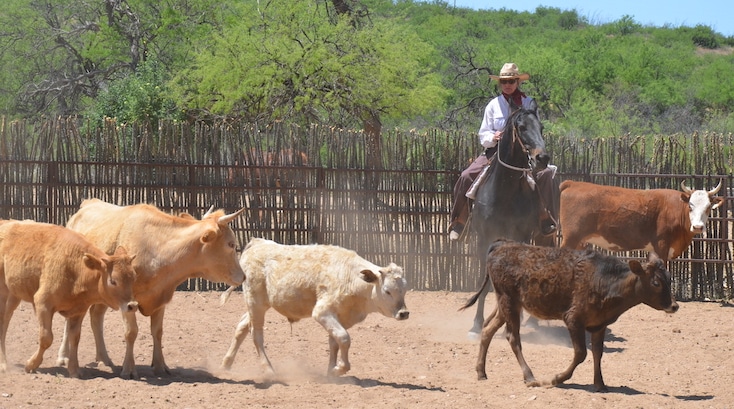
Cattle penning can be a competitive sport on Arizona dude ranches. Horses and cows are both patient with new riders.
Later, back at the ranch, we enjoy group lunches and dinners around a communal table, a breakfast cookout, evening entertainment by Ross, and, the next morning, a long horseback ride into the 117,500-acre Buenos Aires National Wildlife refuge, a relatively lush section of the Sonoran Desert. But the most fun, for me and a handful of other guests, is an exercise referred to as cattle sorting (think super-beginner cutting horse exercise) in which we ride one at a time into a herd of 15 or so shorthorn calves and “cut” one from the group, coaxing it to a pen adjacent to the corral. It took a few goes for me to get the hang of it, but Ross’s tip helped: “Think of it like fishing,” he said. “In fishing you have to outsmart the fish, here you have to outsmart the cow.”
White Stallion Ranch, Tucson
While Rancho de La Osa is a boutique, back-of- beyond kind of place, White Stallion Ranch, in the mountainous country just northwest of Tucson, is a luxury 43-room (plus five-bedroom hacienda) that attracts guests from around the world as well as lots of families during school breaks. The 3,000-acre ranch borders Saguaro National Park and shares much of the same landscape, including thousands of those fantastically shaped cacti, some hundreds of years old, that don’t grow naturally anywhere else.
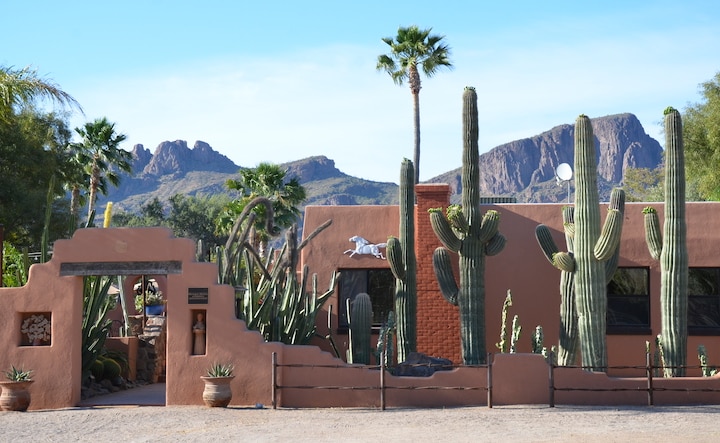
The White Stallion Ranch
A herd of about 170 saddle horses, one of the largest in Arizona, means there’s a mount to fit every ability level, from 5-year-old beginners to horse owners who ride competitively. “We get a lot more intermediate and advanced raiders than many guest ranches,” says True, who grew up on the property recently spiffed up with room renovations and added amenities.
Like Rancho de la Osa, White Stallion is all-inclusive, but it offers a much broader range of activities. Each afternoon, sign-up sheets are put out for the next day’s offerings, which might include wine-and-cheese or beer-and-Cheetos rides (adults only), fat-tire e-bike tours, shooting vintage rifles and pistols, art classes, hiking, team cattle penning, movie tours—or, for an extra charge, top-roped bouldering or single-pitch rock climbing on 30 routes rated beginner to advanced.
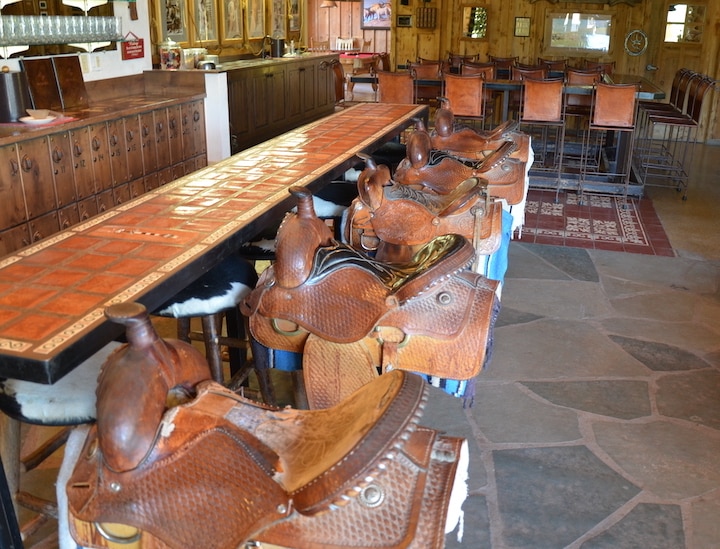
After staying at the White Stallion you can return home and tell all your friends that you spent hours in the saddle.
For those who prefer an open schedule, there’s a pool, a spa, an honor bar with saddles for bar stools (selfie time!) and golf nearby. Another option: hanging out next to the outdoor fireplace on the patio of your guest suite, sipping your beverage of choice and watching the world go by.
Each ranch guest is assigned a horse for the duration of their stay (yes, it’s possible to change)—and lemme tell you, it’s a real luxury to have your mount saddled up and waiting when you arrive at the corral and be able to hand him off to a wrangler at the end of the day, no grooming or heaving of tack required.
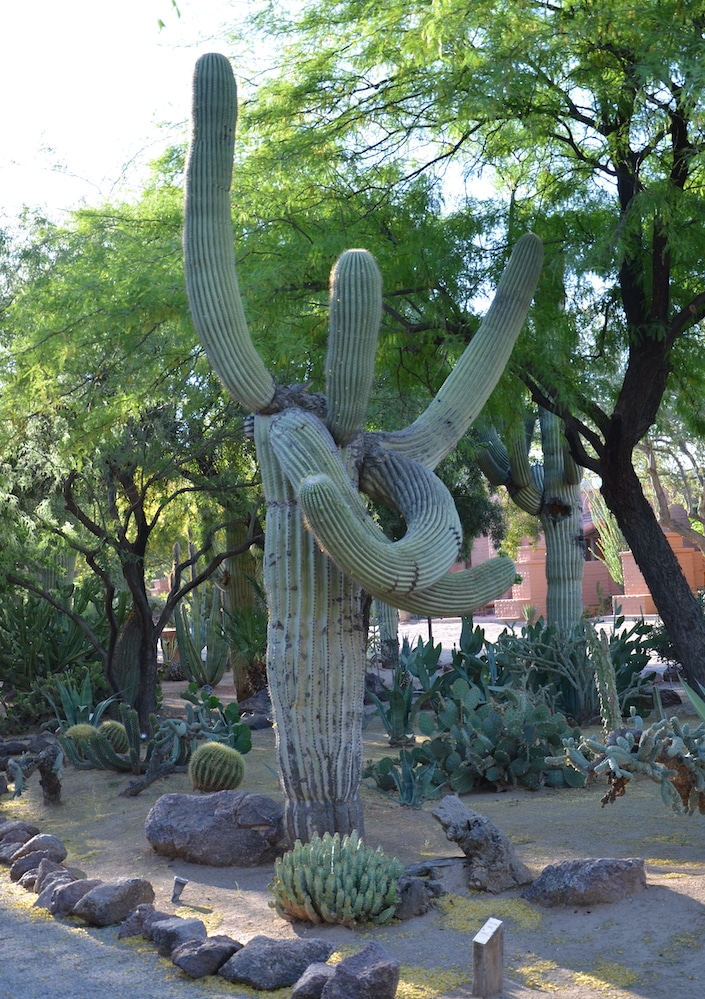
Even the saguaro seem to say “Howdy” at the White Stallion Ranch
My favorite activity: team cattle penning, a competitive, timed event involving cutting a calf from a herd and steering it around the arena into a pen, with one team member serving as the “cutter” and the other three forming a kind of wall to keep the animal from squirting out. Five teams competed during my outing; ours include a cutter from Sweden who took riding lessons for six months before coming to Arizona and had already been on the ranch a week. Three other squadrons were composed of helmeted equestrians from England who had never before ridden Western-style. Our team was awkward at first, but in four go-rounds we cut our time in half, from 28 seconds to 14 to “win” the competition. What did we get for that? Fist bumps, but it was enough!
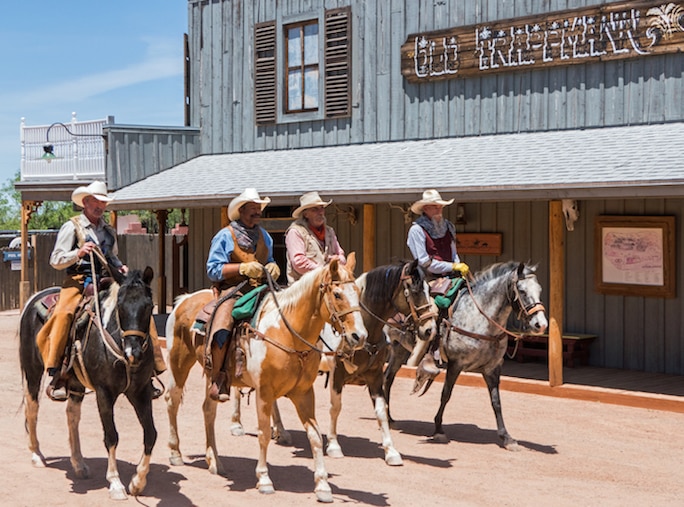
You just never know who will ride into the Tombstone Monument Ranch, a faux western town where little buckaroos can drink sarsaparilla at the bar.
Tombstone Monument Ranch
At first glance, this place is, well, different, a fake 1880s frontier town built by a German developer and targeted to German tourists (Europeans luuuv the American West). The investors went bust but the concept lives on under new ownership, and kids and adults alike can’t help but walk (or maybe swagger) down the dirt road or wooden sidewalks without smiles on their faces and smartphone cameras in hand. With its swinging-doors saloon, Old West signage and guest rooms named for characters from TV and movies (mine was Miss Kitty’s Bordello No. 2), the one-street complex of false-fronted buildings looks and feels like a movie set.
Just three miles down the road, the silver-boom town of Tombstone offers a bigger and more authentic dose of the same thing, replete with costumed characters, a stagecoach, lots of Western-themed shops and saloons, and staged gunfights at the OK Corral (remember Wyatt Earp?) A worthwhile diversion is the Goodenough Silver Mine, a manmade cave hammered out by chisel, hammer and dynamite in the 1880s and one of dozens burrowing under the town.
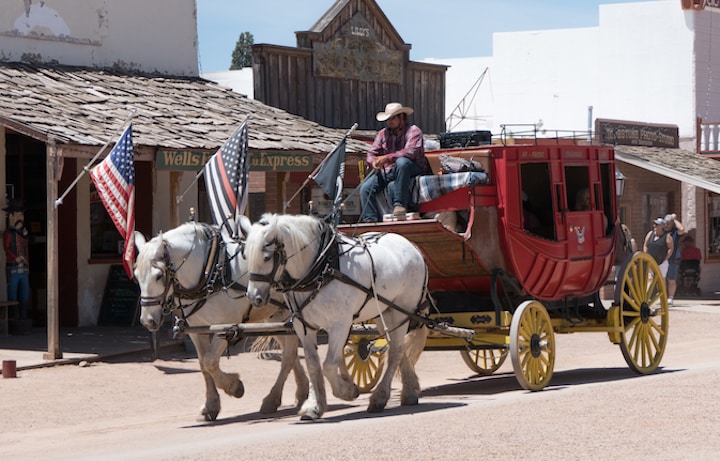
Tombstone, Arizona
Back at the ranch, we ride horses through a landscape pocked with mine shafts and riddled with history. There’s live music in the saloon after dinner and, the next morning a “cowboy breakfast” with a grizzled character who calls himself Arizona John spinning tales around a campfire. Had we stayed another day, we could have ridden horses right into Tombstone and been on the other end of the tourist cameras. But neigh, it was time to go.
Future of Dude Ranches
The exponential growth of cities is the primary reason for the decline in the number of dude ranches. The suburbs of Tucson literally cover most of the ranches that once thrived on the city’s periphery. Ranches with high fixed costs that must be paid despite economic and seasonal fluctuations have responded by becoming “western resorts” that offer outdoor and nature activities in addition to horseback riding. But is that enough?
Some wonder if the mythology of the American West is “too white” to attract the country’s diverse demographic. Certainly western movies and TV shows of the 1950s and 1960s, with the exception of the Cisco Kid, had Anglo protagonists. But anybody who goes to a modern rodeo quickly learns that many of the most accomplished cowboys are Black and Hispanic. “Some people may wonder if today’s ranchers are too rural or too ignorant to be racially welcoming,” muses White Stallion’s Russell True. “Of course this is not the case at all, but perception is reality. I do know at our ranches there has been a very noticeable and accelerating trend toward a more diverse guest mix. Though we can only guess why this is, we are excited about it.”
IF YOU GO
Rancho de La Osa, White Stallion Ranch and Tombstone Monument Ranch can be booked separately or as a three-ranch combo. All three are all-inclusive, meaning meals and unlimited activities are included in the rates (lessons , bar charges and spa services are extra).
Rates: Figure in the neighborhood of $250 -$300 per night single occupancy, $177-$300-plus per person double occupancy in standard guest rooms, plus tax and service charge. (Rates are higher during holidays, while bed-and-board packages may be available in summer).
Season: October-April is the high season in Arizona; prices drop considerably in summer, when temperatures get very hot. Horse-centric workshops, clinics and retreats also are schedule throughout the year. Ask about family specials.
Covid cautions: Despite Covid-19 worries, ranch vacations have survived as all-inclusive, family-friendly options. The ranches, however, do have restrictions and modifications in place. Call before you book to find out how you’ll be affected.
Contact: ranchodelaosa.com, (520) 339-1086; whitestallion.com, (520) 297-0252; tombstonemonumentranch.com, (520) 457-7299![]()
Janet Fullwood is a freelance journalist based in Sacramento and former travel editor and senior writer for the Sacramento Bee and Dallas Times Herald.

